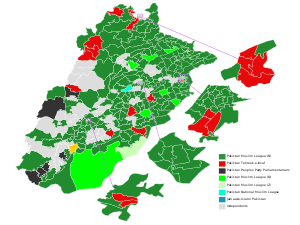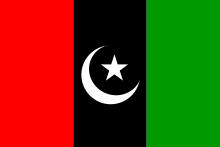2013 Punjab provincial election
Provincial elections were held in the Pakistani province of Punjab on 11 May 2013, alongside nationwide general elections and three other provincial elections in the provinces of Sindh, Balochistan and Khyber Pakhtunkhwa. The remaining two territories of Pakistan, Azad Kashmir and Gilgit-Baltistan, were ineligible to vote due to their disputed status.
| |||||||||||||||||||||||||||||||||||||||||
All 371 seats in the Provincial Assembly 186 seats needed for a majority | |||||||||||||||||||||||||||||||||||||||||
|---|---|---|---|---|---|---|---|---|---|---|---|---|---|---|---|---|---|---|---|---|---|---|---|---|---|---|---|---|---|---|---|---|---|---|---|---|---|---|---|---|---|
| Turnout | 58.52%( | ||||||||||||||||||||||||||||||||||||||||
| |||||||||||||||||||||||||||||||||||||||||
 Punjab Assembly Elections result (expand to original file to see constituency labels) | |||||||||||||||||||||||||||||||||||||||||
| |||||||||||||||||||||||||||||||||||||||||
The Pakistan Muslim League (N) returned triumphant in this elections, retaining Shehbaz Sharif as Chief Minister of Punjab. They obtained 313 out of 371 total seats, giving them a comfortable 4/5 majority in the assembly.
Background
In the 2008 elections, the PML (N) and the PPP formed a coalition government, with PML (N) as the senior party and Shehbaz Sharif as Chief Minister of Punjab.[2] However, in 2011, the PPP was expelled from this coalition due to corruption in the Federal Government, (which was led by the PPP at the time).[3]
Campaign
Overall, due to general mistrust with the federal government, the PML (N) was running on a wave of popular support in Punjab on an anti-PPP platform, due to widespread loadshedding, a slow economic growth rate, and general incompetence in the Federal Level.[4]
On 30 October 2011, former cricketer turned politician Imran Khan held a rally in Punjab's capital city: Lahore. This rally attracted over 100,000 of his supporters and was a power show of his Pakistan Tehreek-e-Insaf. Following this, the popularity of the PTI rapidly increased and it emerged as the main challenger to the PML (N) in Punjab.[5]
Both parties ran on two different platforms: Pakistan Muslim League (N) ran on the issues of tackling the energy conservation crisis, economic reforms and construction of new infrastructure in the country,[6] while the Pakistan Tehreek-e-Insaf ran on a more welfarist, centrist and anti-establishment platform, claiming to be an alternative to both mainstream parties.[7]
Results and government formation
| 313 |
30 |
28 |
| PMLN | PTI | other |
| Party | Vote [8] | % | Seats [9] | ||||
|---|---|---|---|---|---|---|---|
| General | Women | Minorities | Total | % | |||
| Pakistan Muslim League (N) | 11,365,363 | 40.77 | 248 | 58 | 7 | 313 | 84.37 |
| Pakistan Tehreek-e-Insaf | 4,951,216 | 17.76 | 24 | 5 | 1 | 30 | 8.09 |
| Pakistan Peoples Party | 2,464,812 | 8.84 | 7 | 1 | 0 | 8 | 2.16 |
| Pakistan Muslim League (Q) | 1,377,130 | 4.94 | 7 | 1 | 0 | 8 | 2.16 |
| Jamaat-e-Islami | 489,772 | 1.76 | 1 | 0 | 0 | 1 | 0.27 |
| Independents | 6,217,856 | 22.31 | 11 | 0 | 0 | 11 | 2.96 |
| Others | 1,049,708 | 3.77 | 0 | 0 | 0 | 0 | 0 |
| Total | 27,875,857 | 100 | 297 | 66 | 8 | 371 | 100 |
| Registered voters/turnout | 48,534,383 | 58.52 | – | – | – | – | — |
Following the elections, the Pakistan Muslim League (N) came out with well above a supermajority landslide in the assembly with 313 seats, and were comfortably able to form a government. They were followed by the Pakistan Tehreek-e-Insaf, which held only 30 seats.
This election was notable for the downfall of the Pakistan Peoples Party and the Pakistan Muslim League (Q), which both held 106 and 79 seats respectively before the election and were reduced to merely 8 seats each, due to the rise of PTI and PML (N), although the sheer numbers that the PML (N) held in the assembly shocked many analysts.[10]
Shehbaz Sharif, brother of PML (N) chairman and Prime Minister Nawaz Sharif, became Chief Minister for the third time in his life, securing over 300 votes in the assembly.[11]
References
- Election Commission of Pakistan. "GENERAL ELECTIONS - 2013 PROVINCIAL ASSEMBLIES TURNOUT". Election Commission of Pakistan.
- Dawn News. "PPP flexible on Punjab coalition: PML-N". Dawn News.
- Express. "PML-N parts ways with PPP". The Express Tribune.
- House of Commons Library. "Pakistan in 2013" (PDF). House of Commons Library.
- Web Desk. "Imran Khan's 'tsunami' sweeps Lahore". The Express Tribune.
- Declan Walsh; Salman Masood (27 May 2013). "Pakistan Faces Struggle to Keep Its Lights On". The New York Times. Retrieved 28 May 2013.
- "Pakistan Tehreek-e-Insaf – Profile – Insaf – Pakistan Tehreek-e-Insaf Fans Club". Insaf – Pakistan Tehreek-e-Insaf Fans Club. Archived from the original on 2015-04-02. Retrieved 2017-11-18.
- Election Commission of Pakistan. "Party Wise Vote Bank" (PDF). Election Commission of Pakistan.
- Election Commission of Pakistan. "Party Position (Provincial Assembly)" (PDF). Election Commission of Pakistan.
- From the Newspaper. "The election score". Dawn News.
- Web Desk. "Shahbaz Sharif takes oath as Punjab chief minister". The Express Tribune.
.svg.png)
.svg.png)
